Dell EMC PowerStore for Storage Infrastructure Performance and Flexibility
Mid-range storage arrays engineered with data-centric design, intelligent automation and adaptable architecture
This is a Press Release edited by StorageNewsletter.com on May 11, 2020 at 2:24 pmDell Technologies, Inc. announces PowerStore, an infrastructure platform built with superior technology and expertise to address the challenges of the data era.
“Customers tell us a main obstacle keeping them from achieving their digital transformation initiatives is the constant tug-of-war between supporting the ever-increasing number of workloads – from traditional IT applications to data analytics – and the reality of cost constraints, limitations and complexity of their existing IT infrastructure.” said Dan Inbar, president and GM, storage. “Dell EMC PowerStore blends automation, next generation technology, and a novel software architecture to deliver infrastructure that helps organizations address these needs.”
Infrastructure for data era
Organizations can accelerate decision making, data access and application performance with PowerStore, which is designed for 99.9999% availability [2]:
- Any workload: It simplifies IT infrastructure by supporting a range of traditional and workloads with its scale-up, scale-out architecture for block, file and VMware vVols.
- Performance optimized: it is 7x faster [3] and 3x more responsive than previous the company’s mid-range storage arrays [4], because of its end-to-end NVMe design and support for Storage Class Memory as persistent storage powered by dual port Optane SSDs.
- Efficiency: Customers can save on IT budget and capacity with always-on deduplication, compression and a guaranteed 4:1 data reduction [5].
ML and intelligent automation allows for faster delivery of applications and services with up to 99% less staff time to balance volumes [6]
- Programmable infrastructure: Streamlines application development and reduces deployment timeframes from days to seconds [7], with VMware, Inc.’s integration and support formanagement and orchestration frameworks including Kubernetes, Ansible and VMware vRealize Orchestrator.
- Autonomous infrastructure: Built-in machine learning automates labor-intensive processes like initial volume placement, migrations, load balancing and issue resolution.
- Infrastructure Insights: The firm’s CloudIQ storage monitoring and analytics software combines ML and human intelligence for real-time performance and capacity analysis and historical tracking for a single view of the company’s infrastructure. The firm will integrate CloudIQ across the Dell Technologies infrastructure portfolio for greater insights.
Click to enlarge
PowerStore transforms data center operations and allows organizations
to evolve infrastructure in lockstep with everchanging business needs:
- Container-based architecture: PowerStoreOS, the system’s container-based software architecture, enables feature portability, standardization and rapid time-to-market for new capabilities.
- Introducing AppsON: The purpose-built storage array that includes a built-in VMware ESXi Hypervisor [8], administrators can deploy apps directly on the array for flexibility. It is for data-intensive workloads in core or edge locations and infrastructure applications.
- Ease of migration: Native tools within the PowerStore Manager wizard allow customers to automate entire migrations in fewer than 10 clicks [9]. Customers can take advantage of a number of non-disruptive options to migrate from existing storage like Unity, SC, PS Series, VNX and XtremIO.
- Dell Technologies On Demand (DTOD): With DTOD, PowerStore customers can respond to workload spikes and new service requests with elastic capacity and cloud economics. Organizations can choose between 2 flexible pay-per-use consumption models with short-and-long term commitment options, including a new 1-year term for flexible consumption. Global support, deployment and managed services can be included to help simplify IT infrastructure management.
Future-proof program adds anytime upgrades
PowerStore is covered by the the company’s Future-Proof Program, which provides choice, predictability and investment protection through new Anytime Upgrades, a flexible controller upgrade program [10].
Unlike other controller upgrade programs, customers can expand or enhance their PowerStore performance and capacity after 180 days [11]. The combination of Anytime Upgrades and PowerStore’s adaptable architecture effectively ends disruptive platform migrations.
Cloud flexibility with PowerStore
Customers can deploy PowerStore in the way that best meets their cloud strategy and business needs:
- The Cloud Validated Designs for PowerStore for deployment flexibility of demanding workloads in hybrid cloud environments.
- The Cloud Storage Services can directly connect PowerStore to all major public clouds including Amazon Web Services (AWS), Azure and Google Cloud as a managed service. Cloud Storage Services provide DRaaS to VMware Cloud on AWS.
- PowerStore can be deployed as a storage option within PowerOne autonomous infrastructure, which accelerates an organization’s shift to cloud-like operations.
Availability:
- PowerStore is available.
- PowerStore will be available as an option for PowerOne autonomous infrastructure this summer.
Click to enlarge
Steven Kuovo, technology architect, core technology service group, Boston Scientific Corp., said: “Dell EMC PowerStore’s unique architecture and intelligent automation helps us ensure our resources are being used as efficiently as possible while also making sure we’re prepared to scale compute and storage as we need it. We’re excited at the potential that Dell EMC PowerStore has to transform our IT infrastructure.”
Heather Hitchcock, chief commercialization officer, Medical Informatics Corp. (MIC), said: “At Medical Informatics Corp. (MIC), scale and flexibility are critical to the success of our clinical surveillance and analytics solutions. Dell EMC PowerStore’s innovative AppsON capability gives us compute and enterprise-class storage in one system, simplifying our infrastructure while reducing our overall storage footprint. It’s a critical feature as we’re helping hospitals rapidly expand bed capacity and creating flexible, scalable remote monitoring of data across connected devices. Now our healthcare providers have the data they need to intervene faster and provide quality care from any location.”
Eric Burgener, research VP, infrastructure systems, platforms and technologies group, IDC, said: “As organizations modernize their IT infrastructure, they must embrace technology that streamlines operations, eliminates complexity and can scale in the face of exponential data growth. By developing Dell EMC PowerStore through an infrastructure-centric lens, the company has created a platform that can tackle today’s IT challenges while being flexible and scalable enough to meet future IT needs.”
DeMond Sullivan, CTO, Cumberland Group, said: “Dell EMC PowerStore’s unprecedented design, automation and flexibility are game changers for external and midrange storage architectures.This new platform represents a massive opportunity for us in a key segment of storage and we look forward to our customers seeing it firsthand.”
Resources:
PowerStore technical documents and videos
Blog: Inside Dell EMC PowerStore: AppsON Delivers Groundbreaking Application Flexibility and Mobility
Blog: The Business Value of Dell Technologies On Demand for Storage
Blog: Dell EMC CloudIQ: Enabling Faster Time to Insight
Blog: Future Proof Your Dell EMC PowerStore Investment with Anytime Upgrades
(1) IDC WW Quarterly Enterprise Storage Systems Tracker, 2019Q4, March 12, 2020 – Vendor Revenue.
(2) Based on the Dell Technologies specification for Dell EMC PowerStore, April 2020. Actual system availability may vary.
(3) Based on Dell analysis comparing PowerStore 9000 4x cluster to Unity XT 880 running 70/30 random read/write mix, 8K block size with compression and deduplication active, March 2020. Actual performance will vary based on configurations and usage and manufacturing variability.
(4) Based on Dell analysis comparing latency with PowerStore 9000 vs. Unity XT 880 at 300K IOPS, 8K random, 70/30 read/write mix, compression and deduplication active, March 2020. Actual results will vary.
(5) 4:1 average rate guaranteed across customer applications. Rates for individual applications may vary. See Future-Proof program terms and conditions for details. (6) Based on Dell analysis of staff time required to maintain balanced PowerStore cluster vs. traditional multi-array deployment, March 2020. Factors in effort required to monitor, plan, define and execute volume migrations. Actual results will vary.
(7) Based on Dell analysis of effort required to deploy workloads with and without Ansible and vRO orchestration integrations, March 2020. Factors in effort required to monitor, plan, define and execute volume migrations. Actual results will vary.
(8) Based on Dell analysis of publicly available information on current solutions from mainstream storage vendors, April 2020. ESXi Hypervisor is available with PowerStore X models.
(9) Based on Dell internal analysis of minimum effort required to execute non-disruptive migration of volume group using PowerStore’s built-in migration tools for Unity, SC Series, PS Series and VNX arrays, March 2020. Actual results will vary. XtremIO support for built-in migration tools has planned availability later this year.
(10) Based on Dell analysis, April 2020, using publicly available data to compare the highest available program/subscription offers for controller upgrades. Requires purchase of minimum 3-year ProSupport Plus with Anytime Upgrade Select or Standard add-on option at point of sale to qualify.
(11) Upgrade available after 180 days. Requires purchase of minimum 3-year ProSupport Plus with Anytime Upgrade Select or Standard add-on option at point of sale to qualify.
Comments
This new product announcement represents a strategic move for Dell EMC and a compelling offering in the hot mid-range market segment. The product was announced some time ago and finally arrived in 2020 as the company can't wait any longer even if some features are missing today or planned for the future (see below). The concept is interesting as it offers consolidation of usages - storage only or computer + storage - on the same platform thus reducing TCO. Also all features are included with flexible Opex models.
The successor of previous Dell EMC mid-range products, especially Unity, and discontinued VNX, often in conflict, coming from acquisitions like XtremIO, Compellent or EqualLogic or not, introduces a compelling model mixing a pure storage array - PowerStore T - exposing block or block + file interfaces as an unified appliance with dual active/active nodes. Of course, classic interfaces are exposed such FC/iSCSI and NFS/SMB protocols in the base appliance but no NVMe over Fabrics. The Unity NAS service also present on Unity/Unity XT has been containerized and included into PowerStore OS.
The new flavor is the PowerStore X as a combination of block storage array combined with a dual server within the same chassis able to run applications on the embedded ESXi thanks to AppsON and vVols. This is new but creates friction with other Dell EMC VM-oriented and storage + compute convergence solutions even if AppsON targets storage intensive applications.
Dell EMC makes a real effort to provide an universal solution for the mid-range both in term of applications and workloads you can run and use, also for components, and finally for the protocols exposed. Having designed and built a system with PowerStore OS as a container-based architecture leveraging microservices is a key achievement and demonstrates the modularity of the solution. We also anticipate the usage of such approach for the other future Dell EMC storage products.
Adding NVMe dual ported Intel Optane or NVMe SSDs in 2U systems provides performance gain. 3 NVMe entities are possible: NVRAM for write cache, SCM and SSD and you cannot mixed Optane with SSD in same enclosure. You can do NVRAM + SCM or NVRAM + SSD, all SSD are 3D TLC.
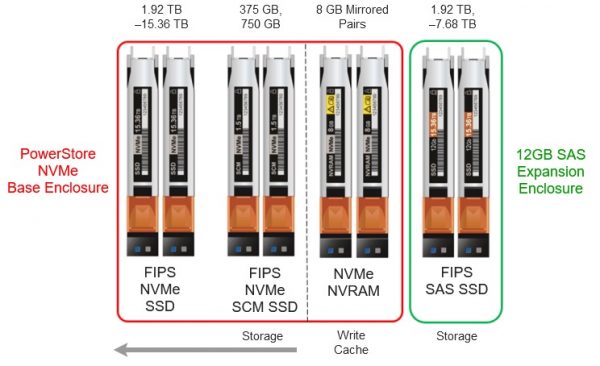
When additional capacity and performance are needed, 2 options are possible: a scale-up with the base appliance connected to 3 SAS-based expansion enclosures maximum for a total of 100 SSDs (25 NVMe + 75 SAS) and scale-out model only available for the T model coupling 4 base appliances maximum i.e 8 nodes. And a cluster can be mixed between 1000, 3000, 5000, 7000 or 10000 models. There is no storage difference between all these models, just CPUs, with different number of cores and memory sizes, we detect also some clock differences, the maximum capacity per appliance is approximately 900TB raw for 817TB usable.
We still have some difficulties with the slogan The future of storage is here on the Dell EMC product page. Future means to be ready for things - circumstances, events, needs and climate - not seen today but anticipated. The immediate comment is PowerStore uses Intel Xeon limited today with PCIe Gen 3 as Intel doesn't have ready Gen 4 capabilities for Xeon family. Intel even recently announced some direction for Optane with PCie Gen 4. Gen 4 is definitely the future, so why Dell EMC finally creates this limitation for this product, does the company receive some guarantee from Intel, may be? On the other hand, AMD Epyc processors already support PCIe Gen 4 and we started to see some U.2 SSDs like Samsung PM1733 and PM1735, Kioxia CD6 and CM6, Netint Codensity D408 SSD to list some or even M.2 SSDs like Adata XPG Sage, Sabrent Rocket, GigaByte Aorus, Corsair MP600 and Samsung again as controllers continue to pop up in different places from Marvell, Innogrit, Microchip/Microsemi, Phison or Netint to name a few.
The second remark about this future direction is the SAS utilization when you need to add capacity to the base appliance. We expect Dell EMC is working on NVMe-oF to upgrade this model, even if here it's for capacity extension and the system considered mid-range. At the same time, Dell signed with Lightbits Labs to offer a NVMe/TCP embedded with the PowerEdge 740xd XL server. It could be an idea and Dell Technologies Capital is also an investor in Lightbits Labs.
In a cluster mode, the file server behavior is limited to the master appliance whatever the number of appliances connected to it. The result is a file service delivered only by a pair of HA nodes, Dell EMC estimates this is enough in mid-range.
In terms of data protection, only a RAID-5 mode is offered in 4+1 or 8+1 configurations and we expected at least a double parity and even a wide erasure coding mode when 4 chassis are coupled with 96 or 98 SSD drives. What about a fixed schema N+2 even +3 with a large N? We find more sophisticated protection in competitive products.
Beyond data protection, data services are pretty rich and we even find similar data reduction ratio i.e 4:1 just announced by Hitachi Vantara for their VSP E990.
PowerStore is an interesting concept and now a real product. We understand Dell EMC push especially for the X model. The T model is a bit behind as engineers spent time on the high level design, tools and integration (AppsON, CloudIQ, vVols, Data Reduction, vRO, CSI/Kubernetes, vSphere/ESXi, Ansible, etc.) and let for the future some storage aspect especially SAS replacement, PCIe Gen 4 and NVMe over Fabrics.
In term of competition, we identify several players for model T or X.
For the T model, pure storage, unified as block + file interfaces or not, we can list:
- Hitachi Vantara VSP E990,
- Pure Storage FlashArray,
- NetApp AFF A400,
- IBM FlashSystem 9200, 7200,
- HPE Nimble Storage,
- Quantum F-2000,
- StorCentric Vexata and Pavilion Hyperparallel, and
- Infinidat Infinibox,
For model X, of course all players offering some sort of compute + storage converging models are competitors. The good thing here again is the choice and flexibility plus agility the platform offers.









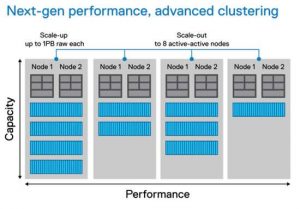
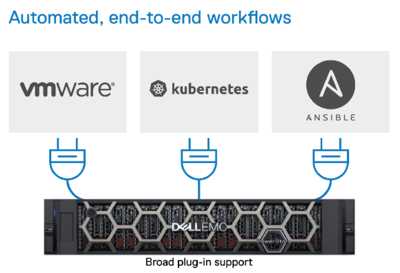
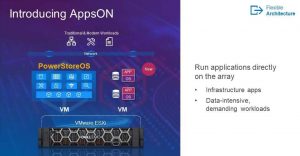
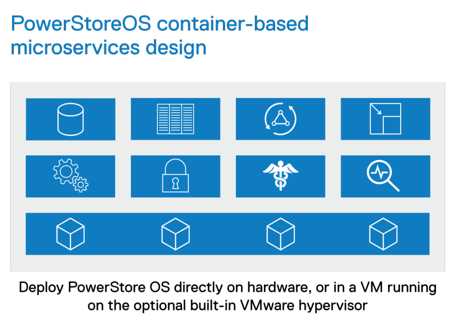
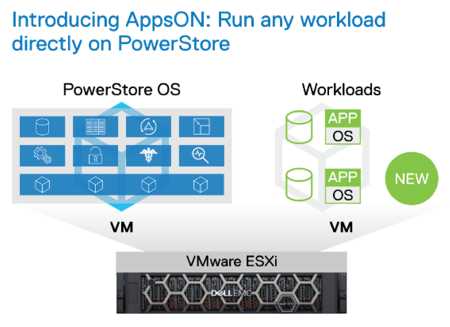
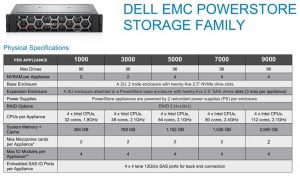
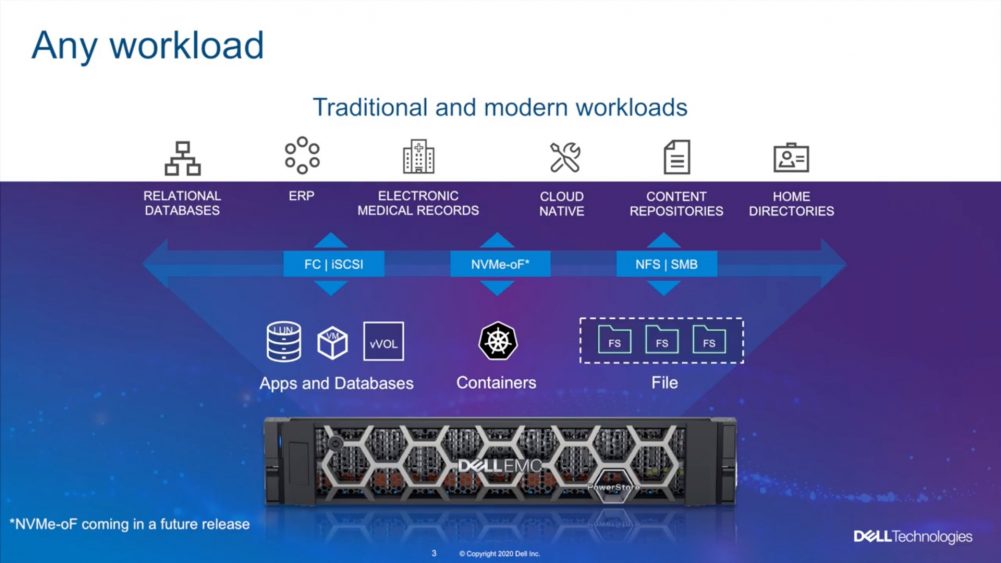






 Subscribe to our free daily newsletter
Subscribe to our free daily newsletter


